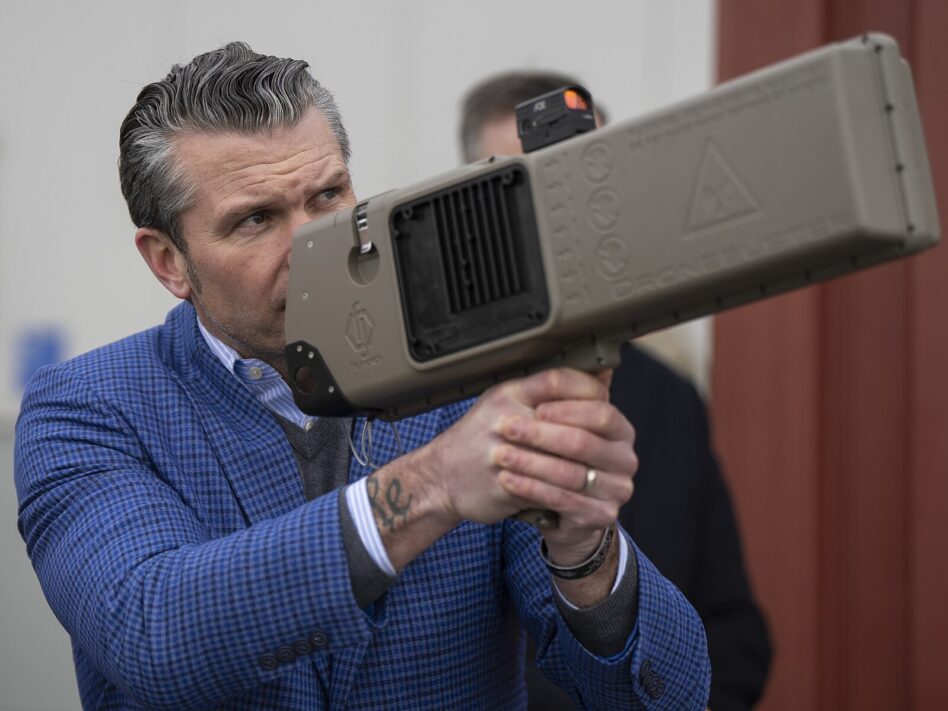Well, the rumors are true. Yesterday, in a typically stylized video (we see you, Pentagon green room), SecDef Pete Hegseth announced the creation of a joint interagency anti-drone task force that will “bring together our best talent from all our agencies to counter these threats and restore control of our skies.” (This was first reported back in July.)
This comes on the heels of President Trump’s “Restoring American Airspace Sovereignty” executive order released in June, which stated that “immediate action is needed to ensure American sovereignty over its skies and that its airspace remains safe and secure” from the threat of UAVs.
“Our job here at the Pentagon…is to prepare for the threats of the future and build a force to match them, and defeat them, and outpace them,” Hegseth said. “And there’s no doubt that the threats we face today from hostile drones grow by the day.”
The outfit will be called Joint Inter-Agency Task Force 401, or JIATF, under the purview of Army Secretary Dan Driscoll.
And for the uninitiated, Hegseth spelled out (quite literally) the kind of systems he wants this task force to oversee. “It’s called counter-UAS—Counter Unmanned Aerial Systems—and America will be the best at it.” Thanks, Pete.
Eye in the sky: Joking aside, the US does face a pretty serious threat from drones both at home and abroad.
- Cartels have, indeed, begun using drones to facilitate drug (and sometimes people) smuggling into the US.
- US bases abroad are under near-constant threat from drones. Remember Tower 22?
- Critical infrastructure around the world—including airports—routinely comes under threat from drones. Famously, Gatwick Airport in the UK had to cancel hundreds of flights in 2018 when it spied drones over its airspace.
- There is also concern over the threat from drones during mass gatherings, like, for example, the LA Olympics in 2028.
Cheap drones—many of them made by DJI in China—can be purchased by pretty much anyone for as little as a few hundred bucks.
Shoot ‘em down: The Pentagon, as a result, has poured money into c-UAS.
- The Pentagon’s FY2026 budget allocates $3.1B across the services to countering drones, a 13.4% increase over the FY2025 budget.
- The One Big Beautiful Bill allocated $500M to c-UAS capabilities.
This all comes as the Pentagon is also promising to “unleash” American Drone Dominance. We get it, guys, drones are cool.
Pick your flavor: Thing is, there are a hell of a lot of ways to get a drone out of the sky, including:
- Electronic Warfare (jamming and spoofing)
- Directed Energy Weapons
- Interceptor drones
- Munitions (bullets and cheap missiles)
Companies we’ve covered from Epirus (laser weapons) to Anduril (EW, missiles, and interceptor drones) to DeDrone (drone tracking and targeting via RF) to Allen Control Systems (automated machine gun) have all doubled down on c-UAS — and have raised a ton of money doing so.
Speedy quick: And it seems they’ve made a pretty solid choice. Hegseth said in the video that the Pentagon is “moving fast, cutting through bureaucracy, consolidating resources, and empowering this task force with the utmost authority to outpace our adversaries.” The goal is to get c-UAS solutions into the hands of frontline soldiers as quickly as possible to make sure they work.
“We’re delivering real solutions [and] ensuring that American airspace remains secure, both here at home for the American people, but also abroad, anywhere American troops are stationed, they deserve to be defended by the best,” he said.

